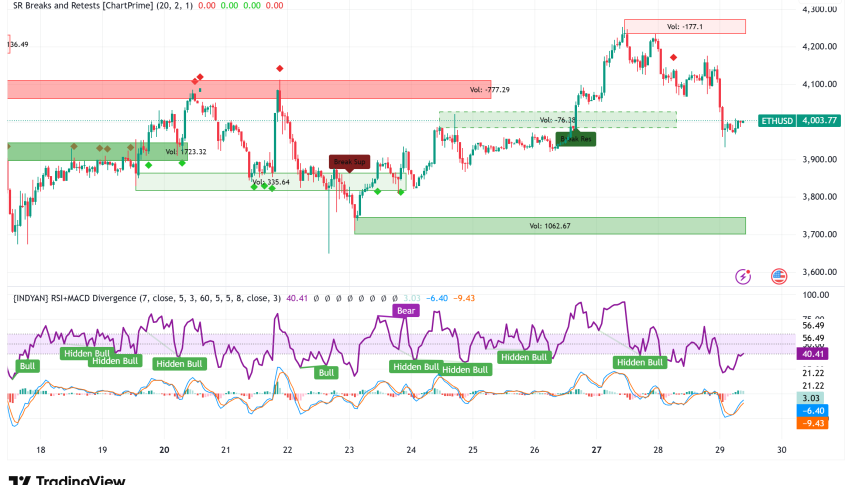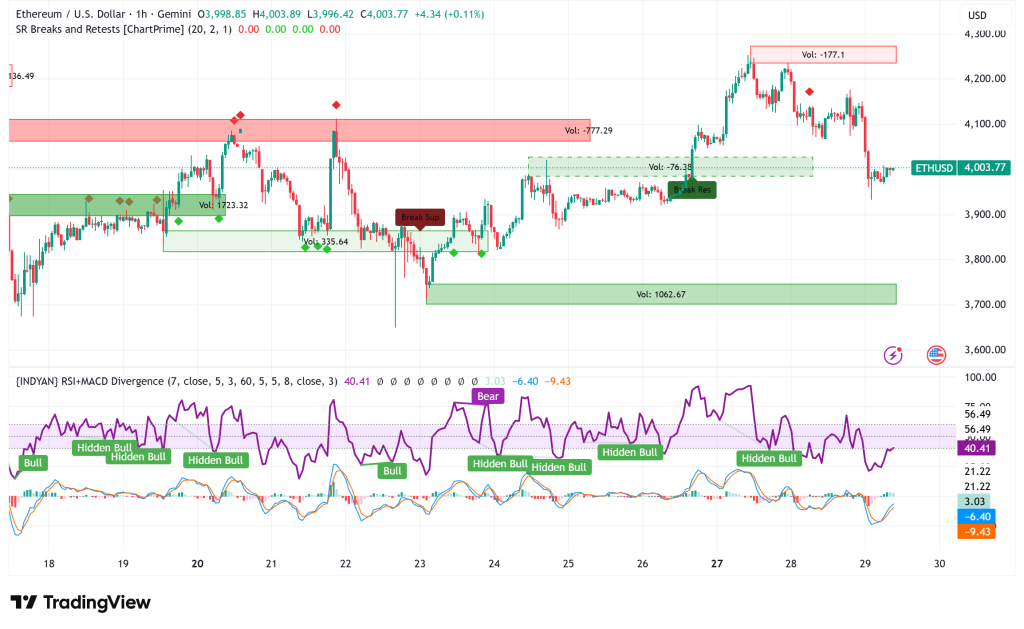Ethereum Tests $4,000 Support, Corporate Adoption Surges Despite Technical Headwinds
Ethereum is at a very important point right now. The second-largest cryptocurrency by market size is trading around $4,000, which is down

Quick overview
- Ethereum is currently trading around $4,000, down 2% in the last 24 hours, with technical indicators suggesting a sluggish market ahead.
- SharpLink Gaming plans to deploy $200 million worth of ETH on Consensys' Linea network, signaling strong institutional confidence in Ethereum's layer-2 ecosystem.
- The successful deployment of the Fusaka upgrade aims to enhance Ethereum's scalability and efficiency, addressing key challenges in the blockchain trilemma.
- Despite some bearish sentiment from ETHZilla's recent asset sales, the long-term outlook for Ethereum remains positive, with potential price targets of $5,000 to $6,000.
Ethereum ETH/USD is at a very important point right now. The second-largest cryptocurrency by market size is trading around $4,000, which is down about 2% in the last 24 hours. Technical indicators suggest that the market could stay sluggish for a while longer before the next leg up happens, even though institutional adoption is at an all-time high and network enhancements are happening faster than ever.

SharpLink’s $200M DeFi Deployment Signals Institutional Confidence
SharpLink Gaming, a company listed on Nasdaq, said it would put $200 million worth of ETH on Consensys’ Linea network. This is a big step forward for corporate crypto treasury management. The project will take several years and will cost about 5.6% of the company’s huge 859,853 ETH treasury, which is worth about $3.57 billion and makes SharpLink the second-largest corporate Ethereum holder in the world.
The deployment plan aims to make money by staking, getting rewards for restaking through EigenCloud’s decentralized verification services, and getting incentives from Linea and ether.fi. This is one of the biggest corporate DeFi deployments to date, and it shows that people are becoming more confident in Ethereum’s layer-2 ecosystem and the chances to earn interest. It is managed by Anchorage Digital Bank, which has institutional safeguards in place.
SharpLink’s approach is in line with what other treasury companies have done. ETHZilla had already said it will provide $100 million to ether.fi. Earlier this year, the Ethereum Foundation itself sent 45,000 ETH to DeFi protocols like Spark and Compound. This tendency of using “productive capital” shows that institutions are entering a stage of growth when they want more than just passive holding.
Fusaka Upgrade Advances Ethereum’s Scalability Roadmap
Ethereum’s Fusaka upgrade was successfully deployed to Hoodi testnet, which is the last place to test it before it goes live on the mainnet on December 3. The upgrade brings a number of important changes, such as Peer Data Availability Sampling (PeerDAS) through EIP-7594. This lets validators work with smaller pieces of data from layer-2 networks instead of complete blobs, which makes nodes perform much better.
As Ethereum gets ready for parallel execution capabilities, more Ethereum Improvement Proposals (EIPs) 7825 and 7935 aim to raise gas limitations and make the network more efficient. These changes fix one part of the “blockchain trilemma” by making Ethereum more scalable while keeping its key qualities in security and decentralization. These are what set it apart from quicker but more centralized competitors like Solana and Sui.
ETHZilla’s Asset Sales Raise Treasury Strategy Concerns
But not all of the news from institutions has been good. ETHZilla recently sold nearly $40 million worth of ETH to pay for $12 million worth of share buybacks. This has led to a lot of discussion in the crypto community on how to manage a company’s treasury. The corporation said it was “balance-sheet arbitrage” to bridge a big gap between the net asset value (NAV) and the market value, but critics say this could lead to bad things.
SalsaTekila, a well-known crypto trader, called the action “extremely bearish,” saying that “if treasury companies start dumping the coin to buy shares, it’s a death spiral setup.” The worry is that selling the underlying asset to boost equity prices could hurt the treasury backing that first drew investors in. The immediate $40 million is only a small amount of daily liquidity for ETH, but if additional treasury corporations start selling because of it, it might cause pro-cyclical selling pressure.
ETH/USD Technical Analysis Points to Near-Term Consolidation
When you look at the price of Ethereum from a technical point of view, it shows that it is weak in the short term. ETH started to go down after hitting a local high of $4,252. It broke through important support levels at $4,150 and $4,050. The asset is now trading below the 100-hourly Simple Moving Average, and technical indications are turning negative.
The hourly MACD is showing more momentum in the bearish zone, and the RSI has fallen below the important 50 mark. Both of these things point to more near-term pressure. The first level of support is around $3,950, and the second level is at $3,920, which is the 61.8% Fibonacci retracement level from the last swing low of $3,708 to the high of $4,252.
If the price breaks below $3,920, it might drop further more into $3,880 and maybe even $3,840. The next important support level is at $3,780. On the other hand, getting back above $4,080 might start a rebound toward $4,120. If it breaks above that level, it could start positive momentum toward $4,200 and the current high at $4,250.
Ethereum Price Prediction: Consolidation Before Next Rally
- Near-term (1-2 weeks): Bearish bias continues, with objectives for the downside around $3,920 to $3,840 if existing support fails. As the markets digest recent gains and wait for more information about the catalysts, expect range-bound consolidation between $3,850 and $4,100.
- Medium-term (1-3 months): The fundamentals are still bullish. The Fusaka upgrade, the sustained use of institutional treasuries, and the rising yields in DeFi should all help the price rise back to $4,500-$4,800 once technical consolidation is over.
- Long-term (6–12 months): Ethereum’s fundamental improvements, layer-2 scaling solutions, and the way institutions are starting to use it all point to a bright prognosis. It seems possible to reach price expectations of $5,000 to $6,000 as network updates make it easier to scale and more companies see ETH as a yield-generating reserve asset.
The latest drop is probably just a healthy correction in an ongoing bull market, not a change in the trend. If you buy Ethereum when it is weak, especially at the $3,920 support zone, you could make money as the coin’s story continues to get stronger through 2025.
- Check out our free forex signals
- Follow the top economic events on FX Leaders economic calendar
- Trade better, discover more Forex Trading Strategies
- Open a FREE Trading Account


